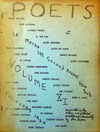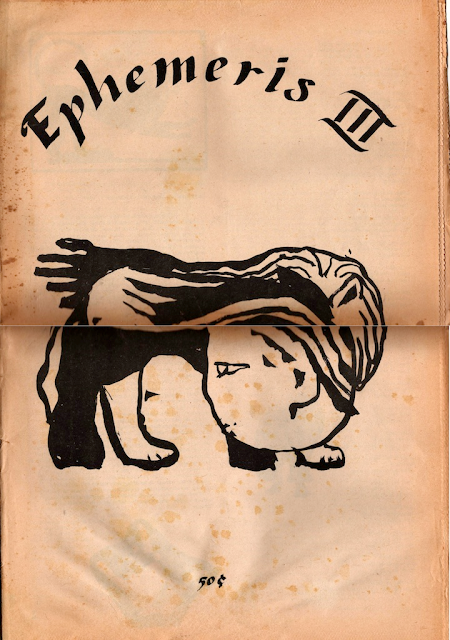The POP project was begun with the idea of cold calling potentially interested and interesting people with the sales pitch of entering into a correspondence. In a world dominated by electronic social media, POP was decidedly lo-tech and seemingly out of touch with current means of communication. I figured that if somebody got in touch with me because of a POP publication, they must really have something to say. And urgently.
Well, Christopher Byck has something to say. He operates 48th Street Press, which publishes chapbooks of “outlaw poets” as well as going full steam ahead with a massive broadside project that in less than four years has issued around 4000 broadsides. Here is an idea of where he is coming from (which you might think is tough to pin down since he travels all over the world). The following quotes come from an interview with Ben Smith of Horror, Sleaze and Trash:
The broadside project was partly inspired by a poetry series that Nettelbeck published from 1980 to 1997, called, This Is Important. These poetry pamphlets were 4" by 11" strips of paper with poems on both sides, folded into a pocket sized reader; each held four to six poems depending on length. They were modeled after religious pamphlets you'd find on a bus, or the subway. In the 80s, Ginsberg and Burroughs, who had largely gravitated away from the small presses, were still submitting to Nettelbeck, along with countless other known (and unknown) poets. He distributed these simple pamphlets wherever people would find them - gas station bathrooms, laundromats, coffee shops, etc. The pamphlets were certainly not 'high-art', but a method to spread poetry.”
My idea is similar. The broadsides are 8.5" by 11" and printed, from a laser printer, on card stock paper of varying colors. Each poet can submit as many poems as they like; generally I will pick two and print them in a numbered edition of 20. The poet signs, numbers and distributes. They can be given away to lovers, waitresses, strangers, at reading, compliments to a book order, or sold for a buck by the poet. I ask that each poet sends me back two broadsides, signed and numbered, to spark distribution and act as a record of the project. This eliminates the need for me to distribute and allows to poet to put a poem into the hands of a reader. They aren't letterpress, no silken paper, just simple ink on card stock - words on paper - each touched by the poet.
I printed nearly 1,100 in 2010, from Philadelphia, and another 1,200 in 2011, from my current home in Caracas, Venezuela. I plan to replicate the project in 2012. I spend about six months perusing online, small press magazines, and chapbooks for what I consider fresh poets. Then, I send off a request for poems. I try to capture a wide range of poets and styles. There are some small press legends, such as John Bennett and A.D. Winans, along with some comparatively new voices to the scene, like u.v. ray and Paul Harrison. I also included some language and visual poets, like John M. Bennett and Richard Kostelanetz. Broadsides have always acted as a 'commercial', if you will, for poets to introduce their work to a reader. I hope my series carries on the tradition.
I do not want to imprison 48th Street with a label but Byck is intensely interested in getting the work of outlaw poets out to general population. Byck describes the Outlaw Poet as follows:
It is difficult to describe an 'Outlaw Poet', mostly, I think, because so many claim to be outlaws. The Kerouac and Bukowski traditions have been beat to hell. If a poet is going to take that road, they had better be exceptional. I think ray and Harrison tread that path and put a unique spin on the content. It's been done, but they elevate the style, add a perspective, and breathe a bit more into it. It's good for a poet to write about drinking, women (or men), and a society that they largely feel disassociated with. However, an outlaw poet needs to possess the unique gift of reporting what they experience in such a way that it hits a reader, creates an image, and allows the reader to share, or relate to the experience.
Here is a good idea of who and what we are talking about: http://outlawlibrary.blogspot.com. The publications of 48th Street are well represented here. This is a remarkable archive compiled by Dave Roskos. Check it out.
Byck got a hold of POP’s The Critical Writings of Douglas Blazek from OLE. In the world of lo-fi publications, a blind squirrel just might find a nut, and Byck has been more than slightly touched by the work of Blazek. He states, “It is impossible to follow the small presses and not see Blazek's named referenced. I read a few, albeit scant, online biographies and the introduction to James DenBoer's bibliography of Blazek’s extensive work. There hasn't been enough written about Blazek, which fueled my curiosity.”
Byck’s curiosity got the best of him yet again, and he sent me a copy of Blazek’s The Song That Ends Ends Our Singing, which 48th Street issued in 2012. It is a small collection in a simple chapbook format, of poems that previously appeared in magazines, like Ecstatic Peace Poetry Journal, Lummox Journal and Prism International. I am blinded by the supposed splendor of the past so I have not seen these current incarnations of the Mimeo Revolution spirit (duplicator), which is truly my loss and to my detriment as someone interested in the history of the little magazine.
The Song That Ends is dedicated to Byck with these lines:
scavenger in the dumpster
Of the poetic past discovering
The secret of dangerous trash
Blazek hits home with me right there, but let’s be clear, unlike the work published by POP, 48th Street is not an operation in ancient archeology. These are not recycled greatest hits. The Song That Ends does not pluck poems from the dumpsters of dangerous trash in which Blazek appeared in the 1960s. These are new poems, which demonstrate Blazek’s current mode in poetry. As Byck states, “It is nearly impossible to recognize the old Blazek in his new work. Essentially, he has re-written hundreds, if not thousands of his previously published poems.” We can debate the merits of this new direction in poetics all day but what interests me is that Blazek has not abandoned the Mimeo Revolution vehicle as a means of distribution. He remains true to the DIY chapbook. And I think Byck has done him a solid in return. The Song That Ends is a joy to get in the mail, a joy to hold in the hand, and a joy to experience on the page. Just like a 45.
Byck also sent me Corrugator by Paul Harrison, a Belfast (Ireland) born poet living in “the world’s most isolated city, Perth, Western Australia.” Harrison could have come straight from the pages of OLE. His work has the Meat School flavor. Last night I had a bone marrow blood pudding with foie gras. Likewise, Harrison’s work is a distillation of blood, guts, sweat, and grit. Not to everybody’s taste, but for those who savor the work of the Meat School, Harrison serves up in Corrugator a collection worth sinking your teeth into.
Harrison reminds me a lot of a poet I have written about before named John Thomas Menesini, out of Pittsburgh. See http://mimeomimeo.blogspot.com/2011/12/john-thomas-menesini.html. What makes John different from Paul is that John really gives you a sense of time and place: white trash, rural, suburban Western PA from the 1980s, which I really like and know a little bit about coming from Eastern PA. Harrison is definitely on the edge, but he is also on the edge of the world in Perth. I get little to no sense of that place although he has clearly taken Belfast with him out there on the ledge. Yet at the same time the poems really do capture a terrifying sense of the void, edge and abyss, a kind of internal Perth. It would be interesting to me if he connected that with the everyday sense (sights, sound, smell, etc) of Perth. But that might be merely interesting to me, not Harrison. In any case, Corrugator is a harrowing act of perception and a raw act of self-examination.
I am eagerly awaiting copies of Byck’s broadsides. Here is a sense of what I have to look forward to: http://www.horrorsleazetrash.com/interviews/48th-street-press-broadsides-project/. You should take the time to wander down 48thStreet as well.










































































